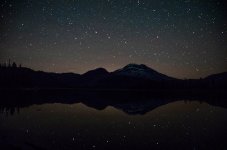You are using an out of date browser. It may not display this or other websites correctly.
You should upgrade or use an alternative browser.
You should upgrade or use an alternative browser.
Light painting
- Thread starter shl3608
- Start date
I'm still learning, so I may not be correct with what I am saying.
If you are shooting RAW, could you try to take two pictures (maybe one with a longer exposure) from a tri-pod (Kind of a given if shooting a night shot like that) and take one of those images and lighten it up as much as you would like to capture the snow, and darken the other enough to let the starts pop? After editing the images, overlay them and mask out the stars or snow in whichever image you wish to be the base layer.
If you want to use like a flash light or something else to make the snow pop... umm I don't know how would get anything to reach that far I would say maybe if your editing skills are really good, try using a painting tool and mess with transparency.
I would say maybe if your editing skills are really good, try using a painting tool and mess with transparency.
Good luck.
If you are shooting RAW, could you try to take two pictures (maybe one with a longer exposure) from a tri-pod (Kind of a given if shooting a night shot like that) and take one of those images and lighten it up as much as you would like to capture the snow, and darken the other enough to let the starts pop? After editing the images, overlay them and mask out the stars or snow in whichever image you wish to be the base layer.
If you want to use like a flash light or something else to make the snow pop... umm I don't know how would get anything to reach that far
Good luck.
WhiteLight
Senior Member
There a lot of options available..
You could bracket shots at different exposures & combine them to HDR (if you like) or use layers in PS to mask different regions of each image.
Another option would be focus stacking
You could bracket shots at different exposures & combine them to HDR (if you like) or use layers in PS to mask different regions of each image.
Another option would be focus stacking
BackdoorArts
Senior Member
I'm just getting into light painting, and as was said, this photograph doesn't qualify as something "paintable". For me light painting has more to do with artificially lighting sections of a photo during the exposure.
With this photo what you likely want is something more akin to a composite and not necessarily the HDR approach suggested. It would require multiple exposures, one exposed for the stars as yours is, and one (or possibly more) that exposes for the the mountains, ignoring the fact that it would make for star trails everywhere else. Using Photoshop you would stack the additional photo(s) as layers on top of this photo and use masks to paint in background areas that were exposed differently. Takes a bit of practice to learn how to blend the edges in a way that looks natural, and how to vary mask opacity layer to layer, but it's very doable and becomes easier with practice.
This differs from the HDR approach, which would be troublesome given the ghosting you'd get from the star trails in the images exposed for the mountains. Some software would handle this more effectively than others, but I suspect it would be more problematic than the composite approach.
With this photo what you likely want is something more akin to a composite and not necessarily the HDR approach suggested. It would require multiple exposures, one exposed for the stars as yours is, and one (or possibly more) that exposes for the the mountains, ignoring the fact that it would make for star trails everywhere else. Using Photoshop you would stack the additional photo(s) as layers on top of this photo and use masks to paint in background areas that were exposed differently. Takes a bit of practice to learn how to blend the edges in a way that looks natural, and how to vary mask opacity layer to layer, but it's very doable and becomes easier with practice.
This differs from the HDR approach, which would be troublesome given the ghosting you'd get from the star trails in the images exposed for the mountains. Some software would handle this more effectively than others, but I suspect it would be more problematic than the composite approach.
BackdoorArts
Senior Member
nikonpup & fastglass, I think your comments make sense. I want to use a flashlight to paint the mountain but it's too far. I think I would have to rely on others comments and try noise reduction in my camera itself and likely get the better glass so I can decrease my ISO.
As mentioned in my post above, exposing in a way that allows the mountain to be visible will likely give you star trails since in the time required to expose the mountain the sky will literally shift in the field of view. That may be something you want, in which case you're covered. But you will not be able to get the sky and reflection you have in your photo and the mountain exposed just by changing ISO. Your available light is all you have and you can't expose for both in a single image.

